Analysis of the Queensland Health Payroll (QHP) Project Failure
VerifiedAdded on 2022/09/14
|10
|2120
|12
Report
AI Summary
This report provides a comprehensive analysis of the Queensland Health Payroll (QHP) project failure, initiated in 2008, which aimed to replace an outdated payroll system. The project, assigned to IBM, encountered significant issues, including incorrect scope and requirements identification, leading to major scope creep and change requests. The report details the major issues such as rush to scope, inexperienced leadership, improper schedule and cost management, and ineffective communication. It highlights failures in early implementation, including unrealistic timelines and ineffective stakeholder management. The report further details cost overruns, schedule delays, and their underlying causes, such as scope creep and project changes. The analysis includes the early delivery method's shortcomings, emphasizing a lack of detailed project planning and poor project governance. Recent delivery changes, including leadership shifts and scope redefinition, are also discussed. The report concludes with recommendations from a project manager's perspective, stressing the importance of scope management and effective communication, and references supporting literature. The report is a valuable resource for understanding the complexities of project management and the critical factors that contribute to project success or failure.
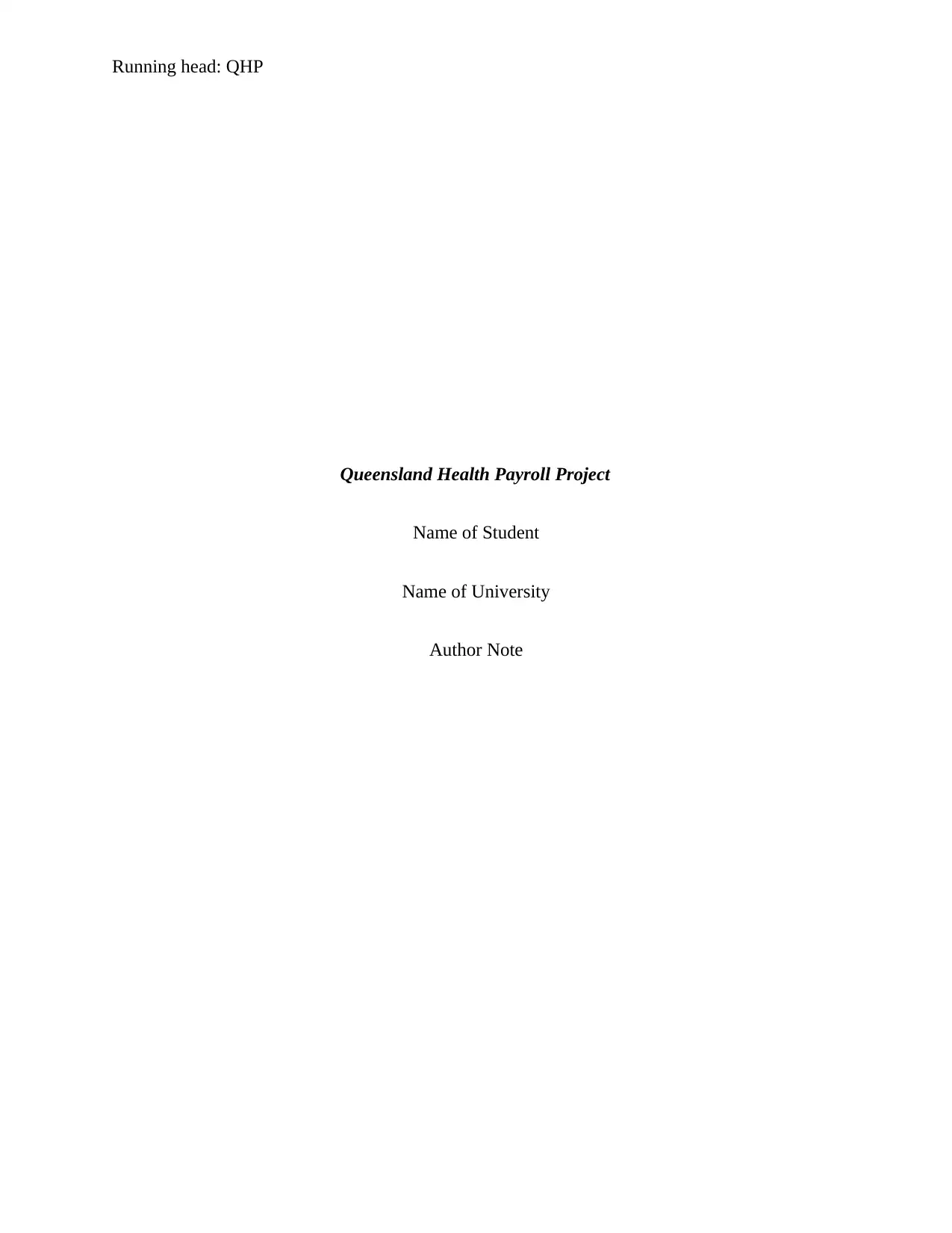
Running head: QHP
Queensland Health Payroll Project
Name of Student
Name of University
Author Note
Queensland Health Payroll Project
Name of Student
Name of University
Author Note
Paraphrase This Document
Need a fresh take? Get an instant paraphrase of this document with our AI Paraphraser
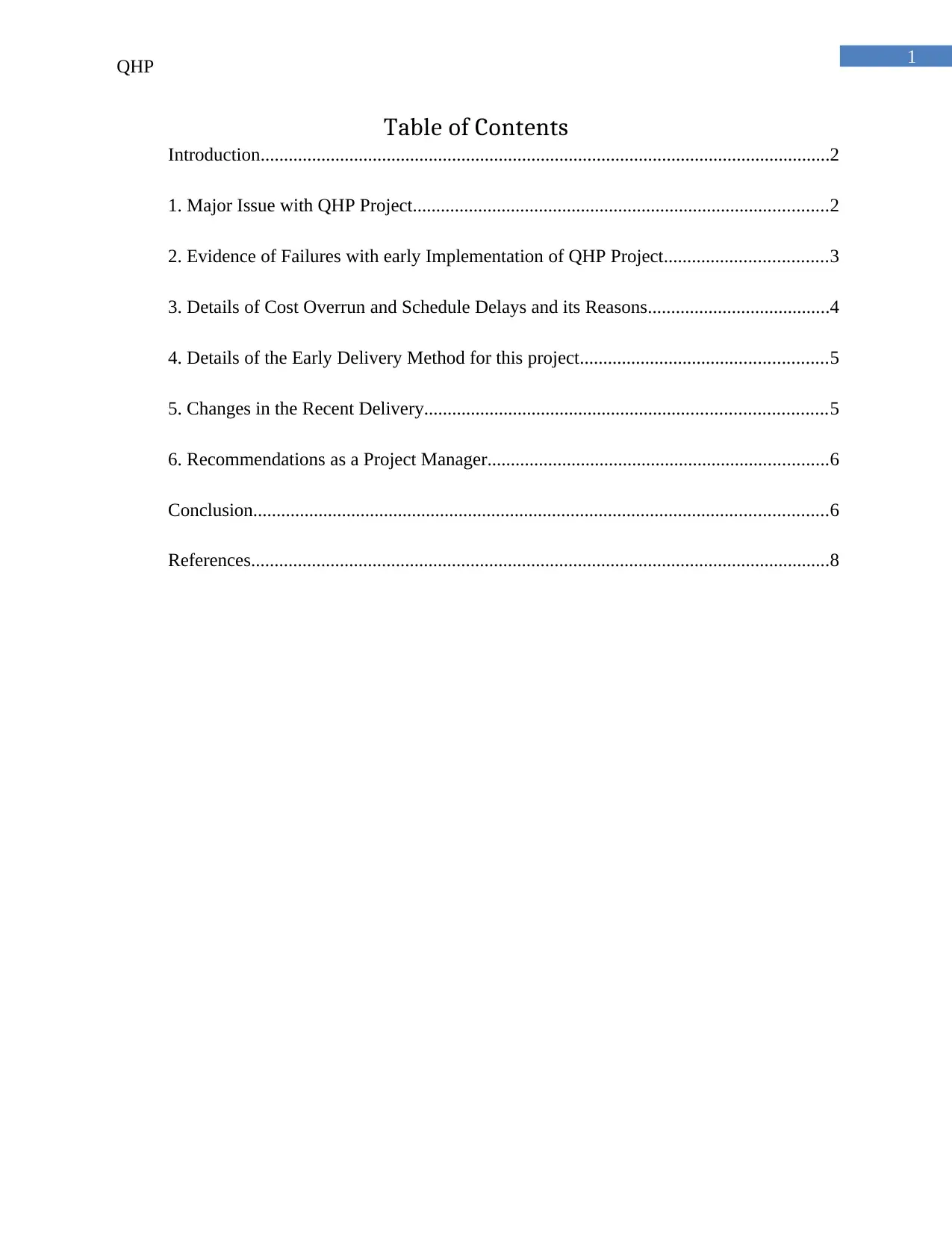
1
QHP
Table of Contents
Introduction..........................................................................................................................2
1. Major Issue with QHP Project.........................................................................................2
2. Evidence of Failures with early Implementation of QHP Project...................................3
3. Details of Cost Overrun and Schedule Delays and its Reasons.......................................4
4. Details of the Early Delivery Method for this project.....................................................5
5. Changes in the Recent Delivery......................................................................................5
6. Recommendations as a Project Manager.........................................................................6
Conclusion...........................................................................................................................6
References............................................................................................................................8
QHP
Table of Contents
Introduction..........................................................................................................................2
1. Major Issue with QHP Project.........................................................................................2
2. Evidence of Failures with early Implementation of QHP Project...................................3
3. Details of Cost Overrun and Schedule Delays and its Reasons.......................................4
4. Details of the Early Delivery Method for this project.....................................................5
5. Changes in the Recent Delivery......................................................................................5
6. Recommendations as a Project Manager.........................................................................6
Conclusion...........................................................................................................................6
References............................................................................................................................8

2
QHP
Introduction
The Queensland Health Payroll (QHP) project was undertaken in the year 2008, with an
aim of replacing its outdated payroll system. The project was given to IBM who took the
responsibility of building a new system (Thite and Sandhu 2014). However, the project proved to
be a standard case of failure as during the phase of system implementation, multiple change
requests were made by the IBM as the requirements of the project was not properly defined. In
the following paragraphs, the major issues associated with the QHP project is discussed along
with the reasons of project failure.
1. Major Issue with QHP Project
The key issues that lead to the failure of the QHP project was incorrect scope and
requirements identification. The scope of the undertaken project was highly underestimated that
contributed to its failure (Eden and Sedera 2014). During the implementation of the project,
major scope creep issues were faced and that lead to several change requests. The major issues
associated with the QHP project are highlighted as follows-
Rush to Scope: Only two months were allocated for management and documentation of
the scope, which lead to ineffective scope documentation. The baseline scope of the project was
established too late, which was a major issue.
Inexperienced leadership: The QHP project was too large and complex. It was IBM
Australia’s first effort of delivering a system which was of such a large size (Paterno and Zhao
2018.). The inexperience of IBM Australia in handling such a large and complex project further
contributed to its failure.
QHP
Introduction
The Queensland Health Payroll (QHP) project was undertaken in the year 2008, with an
aim of replacing its outdated payroll system. The project was given to IBM who took the
responsibility of building a new system (Thite and Sandhu 2014). However, the project proved to
be a standard case of failure as during the phase of system implementation, multiple change
requests were made by the IBM as the requirements of the project was not properly defined. In
the following paragraphs, the major issues associated with the QHP project is discussed along
with the reasons of project failure.
1. Major Issue with QHP Project
The key issues that lead to the failure of the QHP project was incorrect scope and
requirements identification. The scope of the undertaken project was highly underestimated that
contributed to its failure (Eden and Sedera 2014). During the implementation of the project,
major scope creep issues were faced and that lead to several change requests. The major issues
associated with the QHP project are highlighted as follows-
Rush to Scope: Only two months were allocated for management and documentation of
the scope, which lead to ineffective scope documentation. The baseline scope of the project was
established too late, which was a major issue.
Inexperienced leadership: The QHP project was too large and complex. It was IBM
Australia’s first effort of delivering a system which was of such a large size (Paterno and Zhao
2018.). The inexperience of IBM Australia in handling such a large and complex project further
contributed to its failure.
⊘ This is a preview!⊘
Do you want full access?
Subscribe today to unlock all pages.

Trusted by 1+ million students worldwide
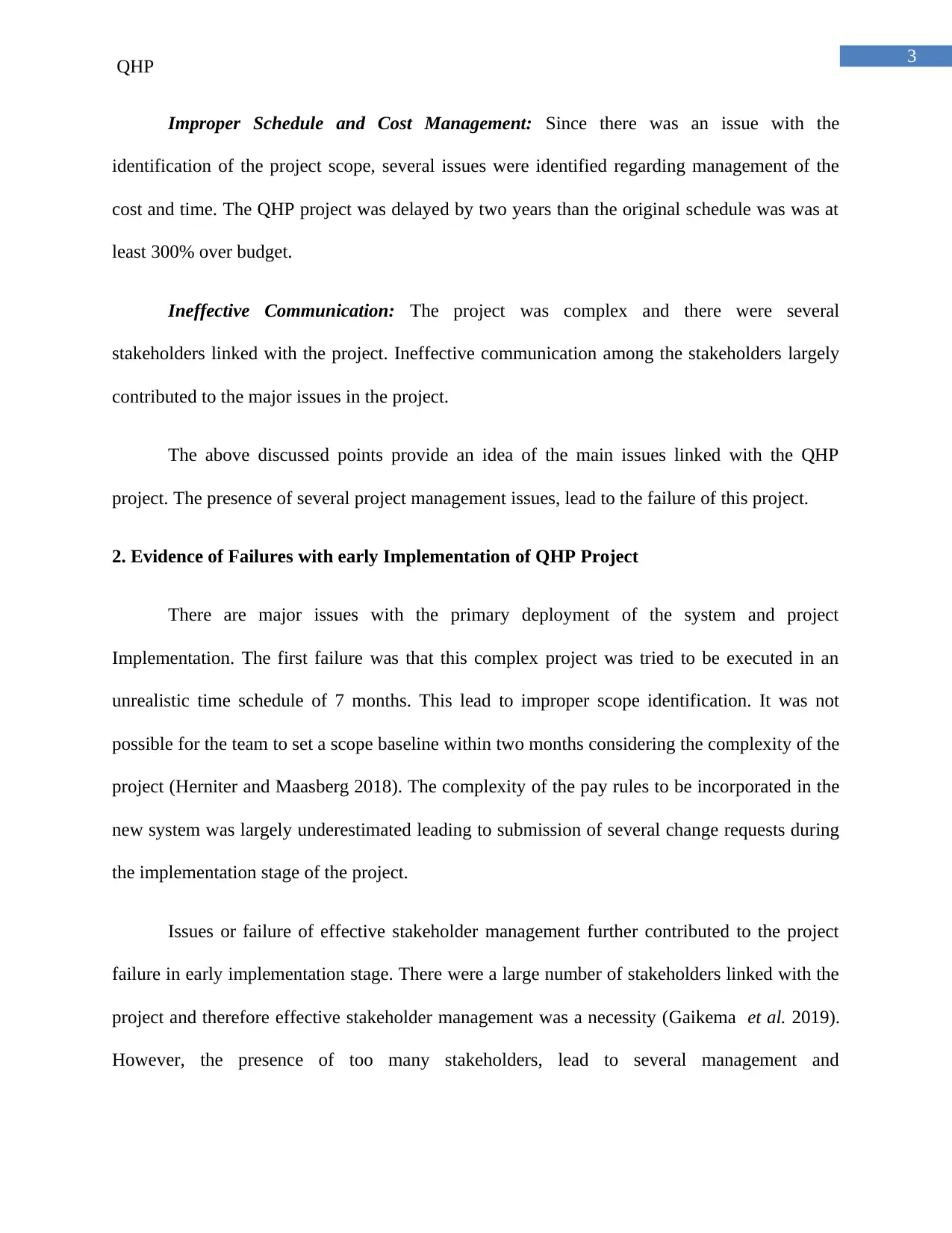
3
QHP
Improper Schedule and Cost Management: Since there was an issue with the
identification of the project scope, several issues were identified regarding management of the
cost and time. The QHP project was delayed by two years than the original schedule was was at
least 300% over budget.
Ineffective Communication: The project was complex and there were several
stakeholders linked with the project. Ineffective communication among the stakeholders largely
contributed to the major issues in the project.
The above discussed points provide an idea of the main issues linked with the QHP
project. The presence of several project management issues, lead to the failure of this project.
2. Evidence of Failures with early Implementation of QHP Project
There are major issues with the primary deployment of the system and project
Implementation. The first failure was that this complex project was tried to be executed in an
unrealistic time schedule of 7 months. This lead to improper scope identification. It was not
possible for the team to set a scope baseline within two months considering the complexity of the
project (Herniter and Maasberg 2018). The complexity of the pay rules to be incorporated in the
new system was largely underestimated leading to submission of several change requests during
the implementation stage of the project.
Issues or failure of effective stakeholder management further contributed to the project
failure in early implementation stage. There were a large number of stakeholders linked with the
project and therefore effective stakeholder management was a necessity (Gaikema et al. 2019).
However, the presence of too many stakeholders, lead to several management and
QHP
Improper Schedule and Cost Management: Since there was an issue with the
identification of the project scope, several issues were identified regarding management of the
cost and time. The QHP project was delayed by two years than the original schedule was was at
least 300% over budget.
Ineffective Communication: The project was complex and there were several
stakeholders linked with the project. Ineffective communication among the stakeholders largely
contributed to the major issues in the project.
The above discussed points provide an idea of the main issues linked with the QHP
project. The presence of several project management issues, lead to the failure of this project.
2. Evidence of Failures with early Implementation of QHP Project
There are major issues with the primary deployment of the system and project
Implementation. The first failure was that this complex project was tried to be executed in an
unrealistic time schedule of 7 months. This lead to improper scope identification. It was not
possible for the team to set a scope baseline within two months considering the complexity of the
project (Herniter and Maasberg 2018). The complexity of the pay rules to be incorporated in the
new system was largely underestimated leading to submission of several change requests during
the implementation stage of the project.
Issues or failure of effective stakeholder management further contributed to the project
failure in early implementation stage. There were a large number of stakeholders linked with the
project and therefore effective stakeholder management was a necessity (Gaikema et al. 2019).
However, the presence of too many stakeholders, lead to several management and
Paraphrase This Document
Need a fresh take? Get an instant paraphrase of this document with our AI Paraphraser
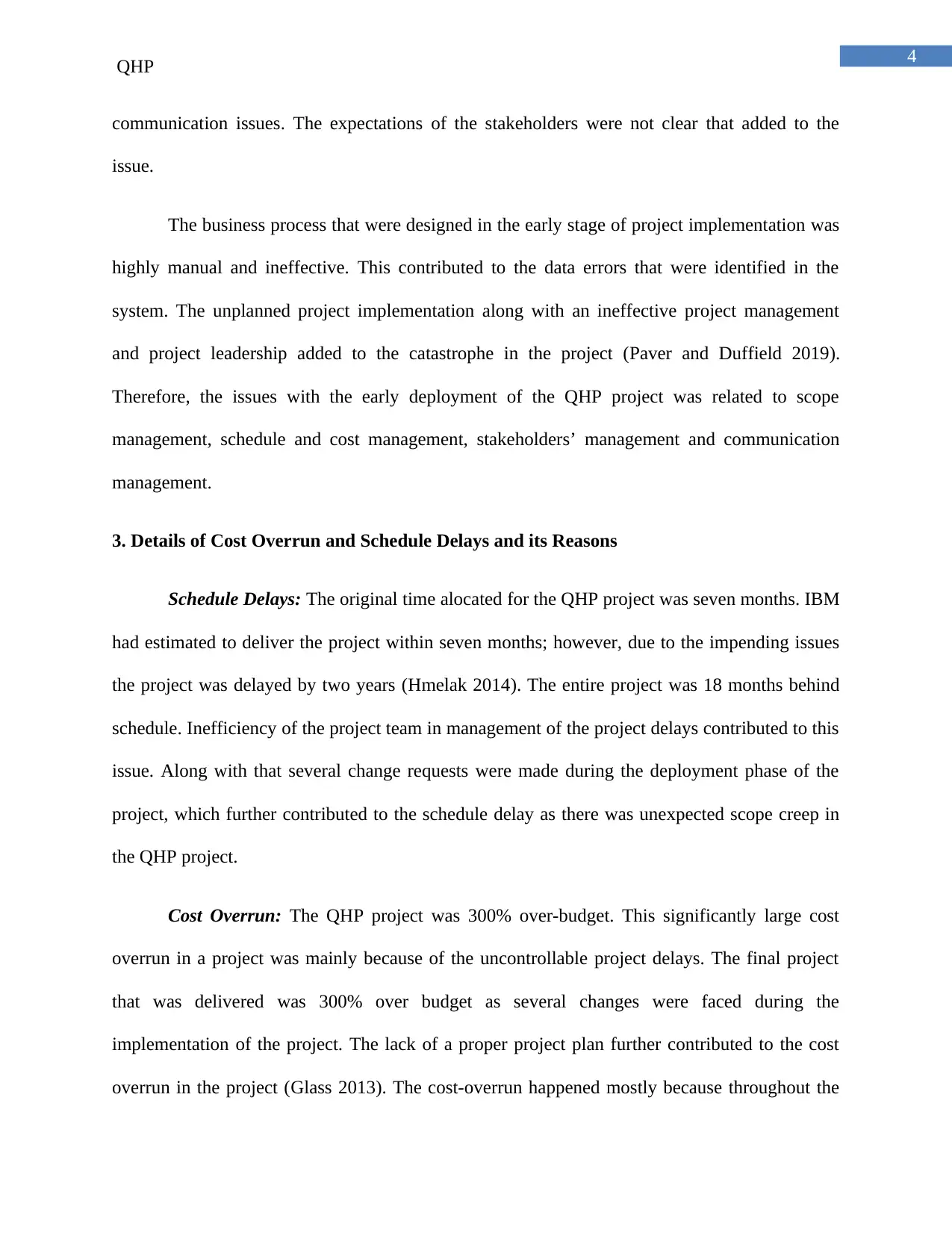
4
QHP
communication issues. The expectations of the stakeholders were not clear that added to the
issue.
The business process that were designed in the early stage of project implementation was
highly manual and ineffective. This contributed to the data errors that were identified in the
system. The unplanned project implementation along with an ineffective project management
and project leadership added to the catastrophe in the project (Paver and Duffield 2019).
Therefore, the issues with the early deployment of the QHP project was related to scope
management, schedule and cost management, stakeholders’ management and communication
management.
3. Details of Cost Overrun and Schedule Delays and its Reasons
Schedule Delays: The original time alocated for the QHP project was seven months. IBM
had estimated to deliver the project within seven months; however, due to the impending issues
the project was delayed by two years (Hmelak 2014). The entire project was 18 months behind
schedule. Inefficiency of the project team in management of the project delays contributed to this
issue. Along with that several change requests were made during the deployment phase of the
project, which further contributed to the schedule delay as there was unexpected scope creep in
the QHP project.
Cost Overrun: The QHP project was 300% over-budget. This significantly large cost
overrun in a project was mainly because of the uncontrollable project delays. The final project
that was delivered was 300% over budget as several changes were faced during the
implementation of the project. The lack of a proper project plan further contributed to the cost
overrun in the project (Glass 2013). The cost-overrun happened mostly because throughout the
QHP
communication issues. The expectations of the stakeholders were not clear that added to the
issue.
The business process that were designed in the early stage of project implementation was
highly manual and ineffective. This contributed to the data errors that were identified in the
system. The unplanned project implementation along with an ineffective project management
and project leadership added to the catastrophe in the project (Paver and Duffield 2019).
Therefore, the issues with the early deployment of the QHP project was related to scope
management, schedule and cost management, stakeholders’ management and communication
management.
3. Details of Cost Overrun and Schedule Delays and its Reasons
Schedule Delays: The original time alocated for the QHP project was seven months. IBM
had estimated to deliver the project within seven months; however, due to the impending issues
the project was delayed by two years (Hmelak 2014). The entire project was 18 months behind
schedule. Inefficiency of the project team in management of the project delays contributed to this
issue. Along with that several change requests were made during the deployment phase of the
project, which further contributed to the schedule delay as there was unexpected scope creep in
the QHP project.
Cost Overrun: The QHP project was 300% over-budget. This significantly large cost
overrun in a project was mainly because of the uncontrollable project delays. The final project
that was delivered was 300% over budget as several changes were faced during the
implementation of the project. The lack of a proper project plan further contributed to the cost
overrun in the project (Glass 2013). The cost-overrun happened mostly because throughout the
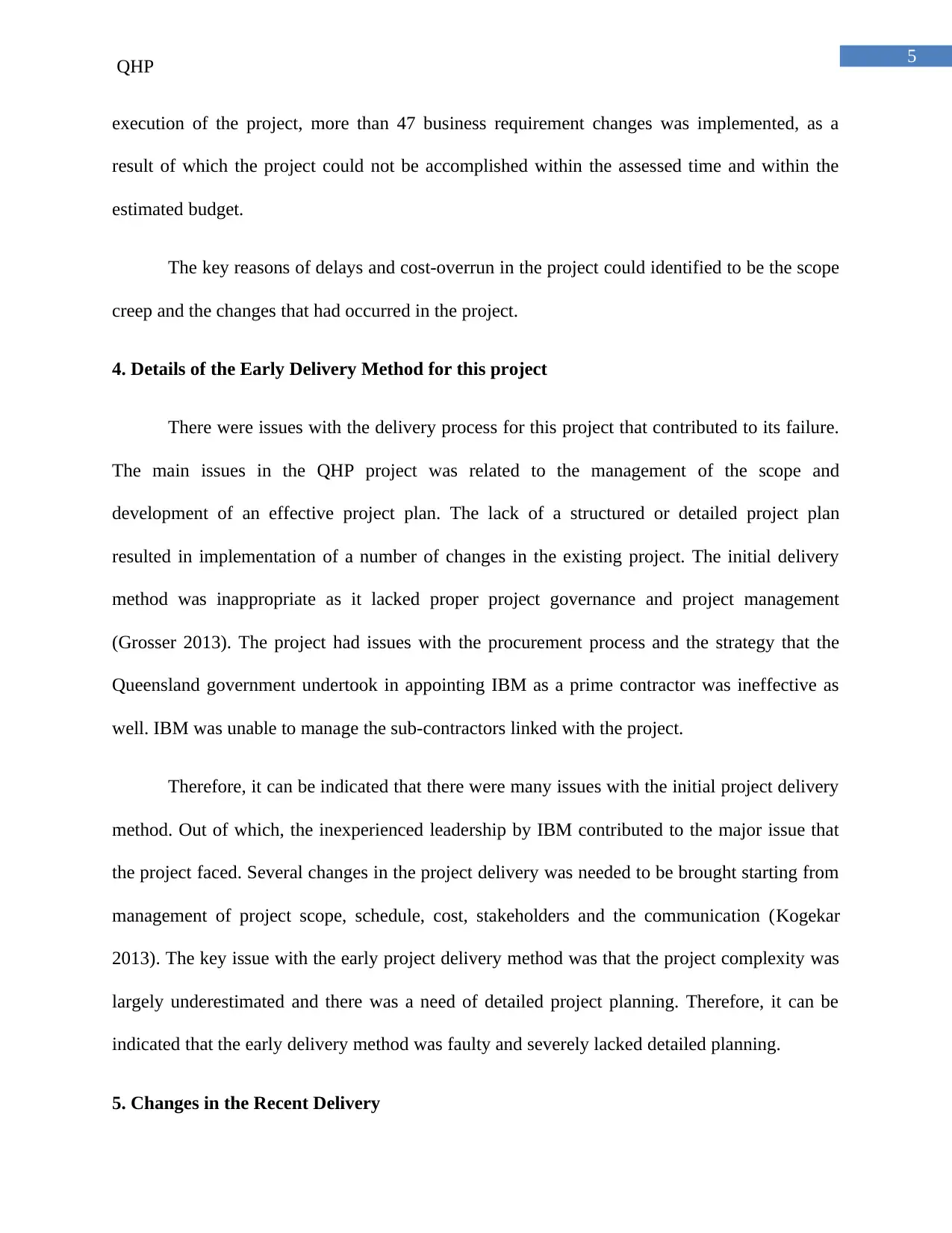
5
QHP
execution of the project, more than 47 business requirement changes was implemented, as a
result of which the project could not be accomplished within the assessed time and within the
estimated budget.
The key reasons of delays and cost-overrun in the project could identified to be the scope
creep and the changes that had occurred in the project.
4. Details of the Early Delivery Method for this project
There were issues with the delivery process for this project that contributed to its failure.
The main issues in the QHP project was related to the management of the scope and
development of an effective project plan. The lack of a structured or detailed project plan
resulted in implementation of a number of changes in the existing project. The initial delivery
method was inappropriate as it lacked proper project governance and project management
(Grosser 2013). The project had issues with the procurement process and the strategy that the
Queensland government undertook in appointing IBM as a prime contractor was ineffective as
well. IBM was unable to manage the sub-contractors linked with the project.
Therefore, it can be indicated that there were many issues with the initial project delivery
method. Out of which, the inexperienced leadership by IBM contributed to the major issue that
the project faced. Several changes in the project delivery was needed to be brought starting from
management of project scope, schedule, cost, stakeholders and the communication (Kogekar
2013). The key issue with the early project delivery method was that the project complexity was
largely underestimated and there was a need of detailed project planning. Therefore, it can be
indicated that the early delivery method was faulty and severely lacked detailed planning.
5. Changes in the Recent Delivery
QHP
execution of the project, more than 47 business requirement changes was implemented, as a
result of which the project could not be accomplished within the assessed time and within the
estimated budget.
The key reasons of delays and cost-overrun in the project could identified to be the scope
creep and the changes that had occurred in the project.
4. Details of the Early Delivery Method for this project
There were issues with the delivery process for this project that contributed to its failure.
The main issues in the QHP project was related to the management of the scope and
development of an effective project plan. The lack of a structured or detailed project plan
resulted in implementation of a number of changes in the existing project. The initial delivery
method was inappropriate as it lacked proper project governance and project management
(Grosser 2013). The project had issues with the procurement process and the strategy that the
Queensland government undertook in appointing IBM as a prime contractor was ineffective as
well. IBM was unable to manage the sub-contractors linked with the project.
Therefore, it can be indicated that there were many issues with the initial project delivery
method. Out of which, the inexperienced leadership by IBM contributed to the major issue that
the project faced. Several changes in the project delivery was needed to be brought starting from
management of project scope, schedule, cost, stakeholders and the communication (Kogekar
2013). The key issue with the early project delivery method was that the project complexity was
largely underestimated and there was a need of detailed project planning. Therefore, it can be
indicated that the early delivery method was faulty and severely lacked detailed planning.
5. Changes in the Recent Delivery
⊘ This is a preview!⊘
Do you want full access?
Subscribe today to unlock all pages.

Trusted by 1+ million students worldwide
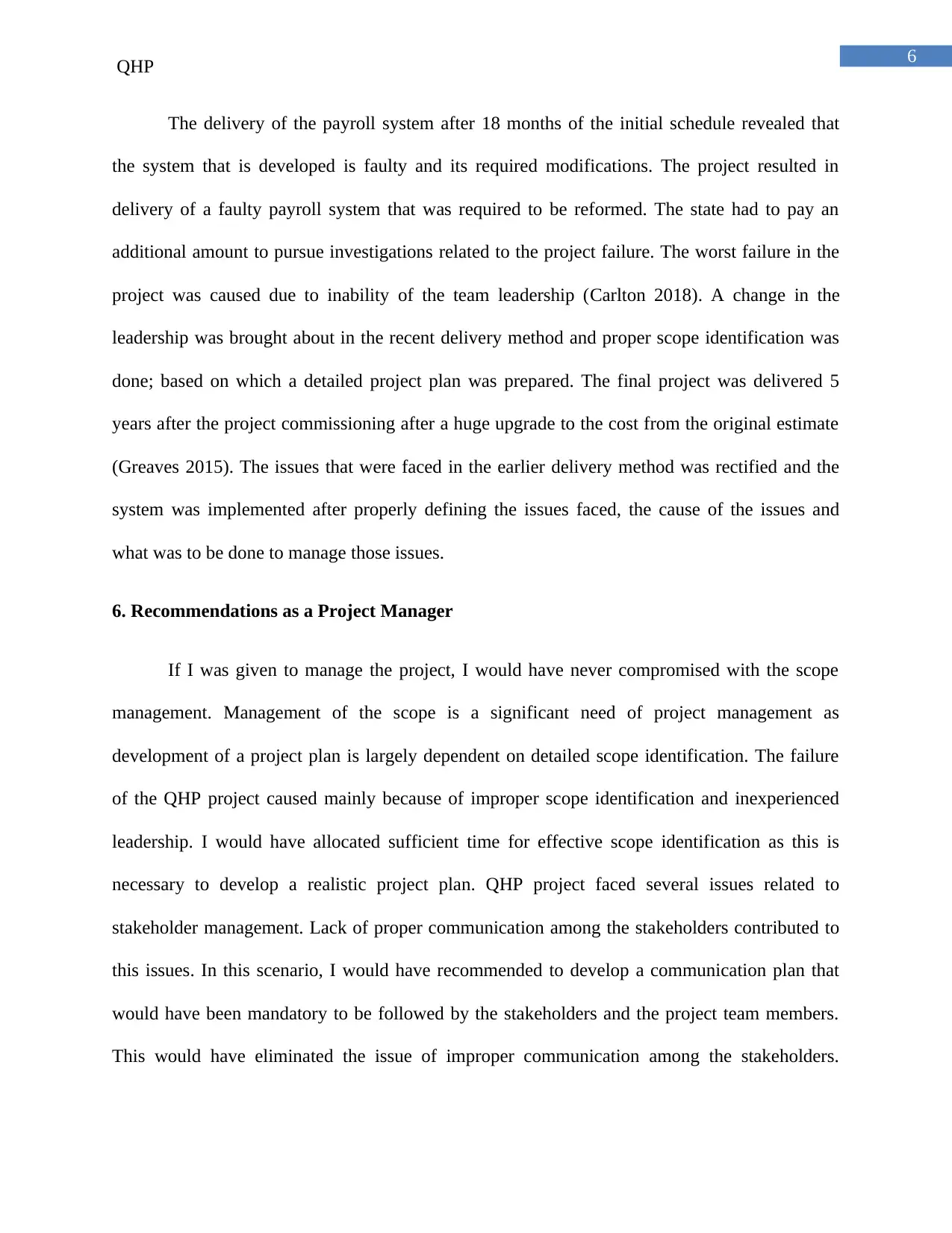
6
QHP
The delivery of the payroll system after 18 months of the initial schedule revealed that
the system that is developed is faulty and its required modifications. The project resulted in
delivery of a faulty payroll system that was required to be reformed. The state had to pay an
additional amount to pursue investigations related to the project failure. The worst failure in the
project was caused due to inability of the team leadership (Carlton 2018). A change in the
leadership was brought about in the recent delivery method and proper scope identification was
done; based on which a detailed project plan was prepared. The final project was delivered 5
years after the project commissioning after a huge upgrade to the cost from the original estimate
(Greaves 2015). The issues that were faced in the earlier delivery method was rectified and the
system was implemented after properly defining the issues faced, the cause of the issues and
what was to be done to manage those issues.
6. Recommendations as a Project Manager
If I was given to manage the project, I would have never compromised with the scope
management. Management of the scope is a significant need of project management as
development of a project plan is largely dependent on detailed scope identification. The failure
of the QHP project caused mainly because of improper scope identification and inexperienced
leadership. I would have allocated sufficient time for effective scope identification as this is
necessary to develop a realistic project plan. QHP project faced several issues related to
stakeholder management. Lack of proper communication among the stakeholders contributed to
this issues. In this scenario, I would have recommended to develop a communication plan that
would have been mandatory to be followed by the stakeholders and the project team members.
This would have eliminated the issue of improper communication among the stakeholders.
QHP
The delivery of the payroll system after 18 months of the initial schedule revealed that
the system that is developed is faulty and its required modifications. The project resulted in
delivery of a faulty payroll system that was required to be reformed. The state had to pay an
additional amount to pursue investigations related to the project failure. The worst failure in the
project was caused due to inability of the team leadership (Carlton 2018). A change in the
leadership was brought about in the recent delivery method and proper scope identification was
done; based on which a detailed project plan was prepared. The final project was delivered 5
years after the project commissioning after a huge upgrade to the cost from the original estimate
(Greaves 2015). The issues that were faced in the earlier delivery method was rectified and the
system was implemented after properly defining the issues faced, the cause of the issues and
what was to be done to manage those issues.
6. Recommendations as a Project Manager
If I was given to manage the project, I would have never compromised with the scope
management. Management of the scope is a significant need of project management as
development of a project plan is largely dependent on detailed scope identification. The failure
of the QHP project caused mainly because of improper scope identification and inexperienced
leadership. I would have allocated sufficient time for effective scope identification as this is
necessary to develop a realistic project plan. QHP project faced several issues related to
stakeholder management. Lack of proper communication among the stakeholders contributed to
this issues. In this scenario, I would have recommended to develop a communication plan that
would have been mandatory to be followed by the stakeholders and the project team members.
This would have eliminated the issue of improper communication among the stakeholders.
Paraphrase This Document
Need a fresh take? Get an instant paraphrase of this document with our AI Paraphraser
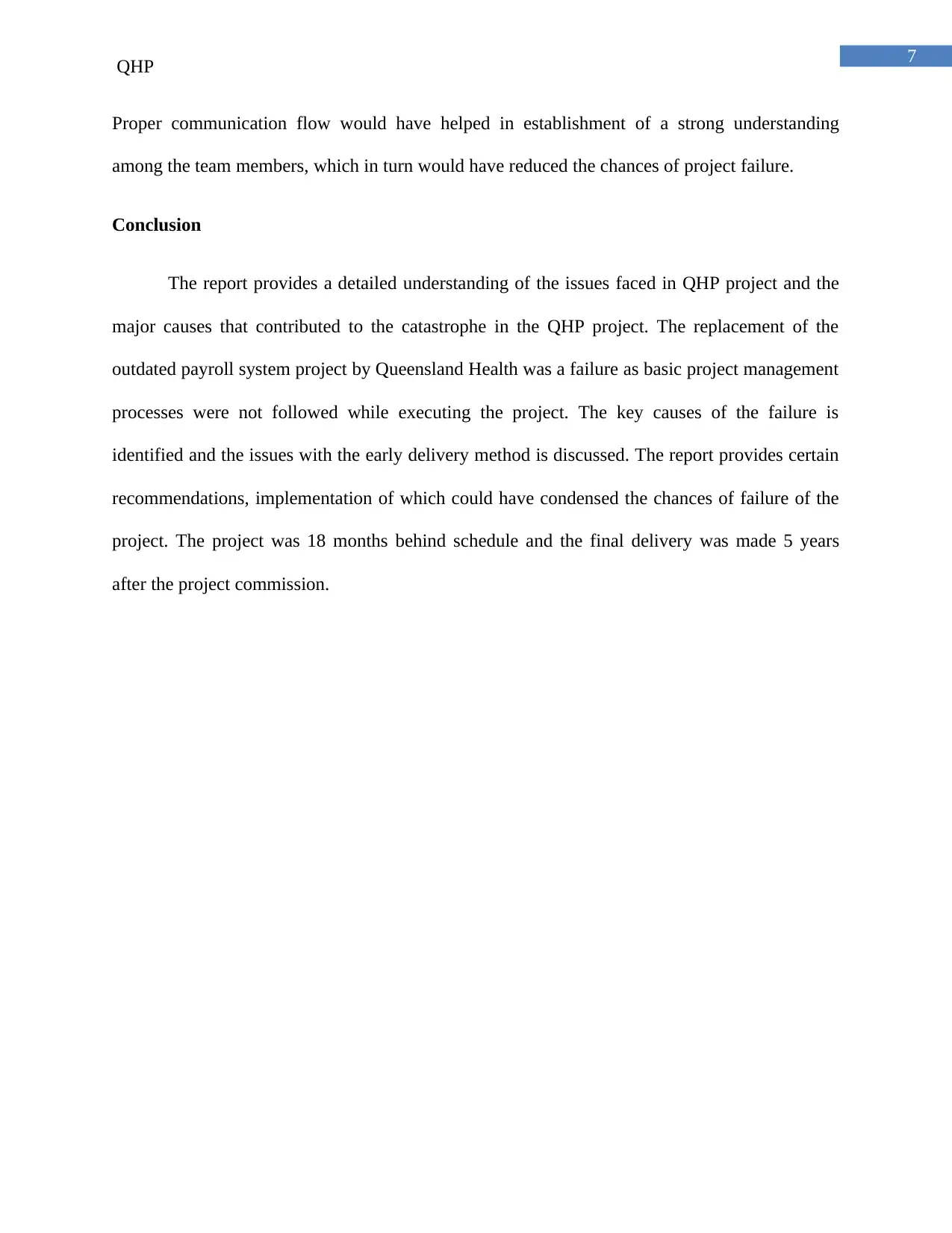
7
QHP
Proper communication flow would have helped in establishment of a strong understanding
among the team members, which in turn would have reduced the chances of project failure.
Conclusion
The report provides a detailed understanding of the issues faced in QHP project and the
major causes that contributed to the catastrophe in the QHP project. The replacement of the
outdated payroll system project by Queensland Health was a failure as basic project management
processes were not followed while executing the project. The key causes of the failure is
identified and the issues with the early delivery method is discussed. The report provides certain
recommendations, implementation of which could have condensed the chances of failure of the
project. The project was 18 months behind schedule and the final delivery was made 5 years
after the project commission.
QHP
Proper communication flow would have helped in establishment of a strong understanding
among the team members, which in turn would have reduced the chances of project failure.
Conclusion
The report provides a detailed understanding of the issues faced in QHP project and the
major causes that contributed to the catastrophe in the QHP project. The replacement of the
outdated payroll system project by Queensland Health was a failure as basic project management
processes were not followed while executing the project. The key causes of the failure is
identified and the issues with the early delivery method is discussed. The report provides certain
recommendations, implementation of which could have condensed the chances of failure of the
project. The project was 18 months behind schedule and the final delivery was made 5 years
after the project commission.
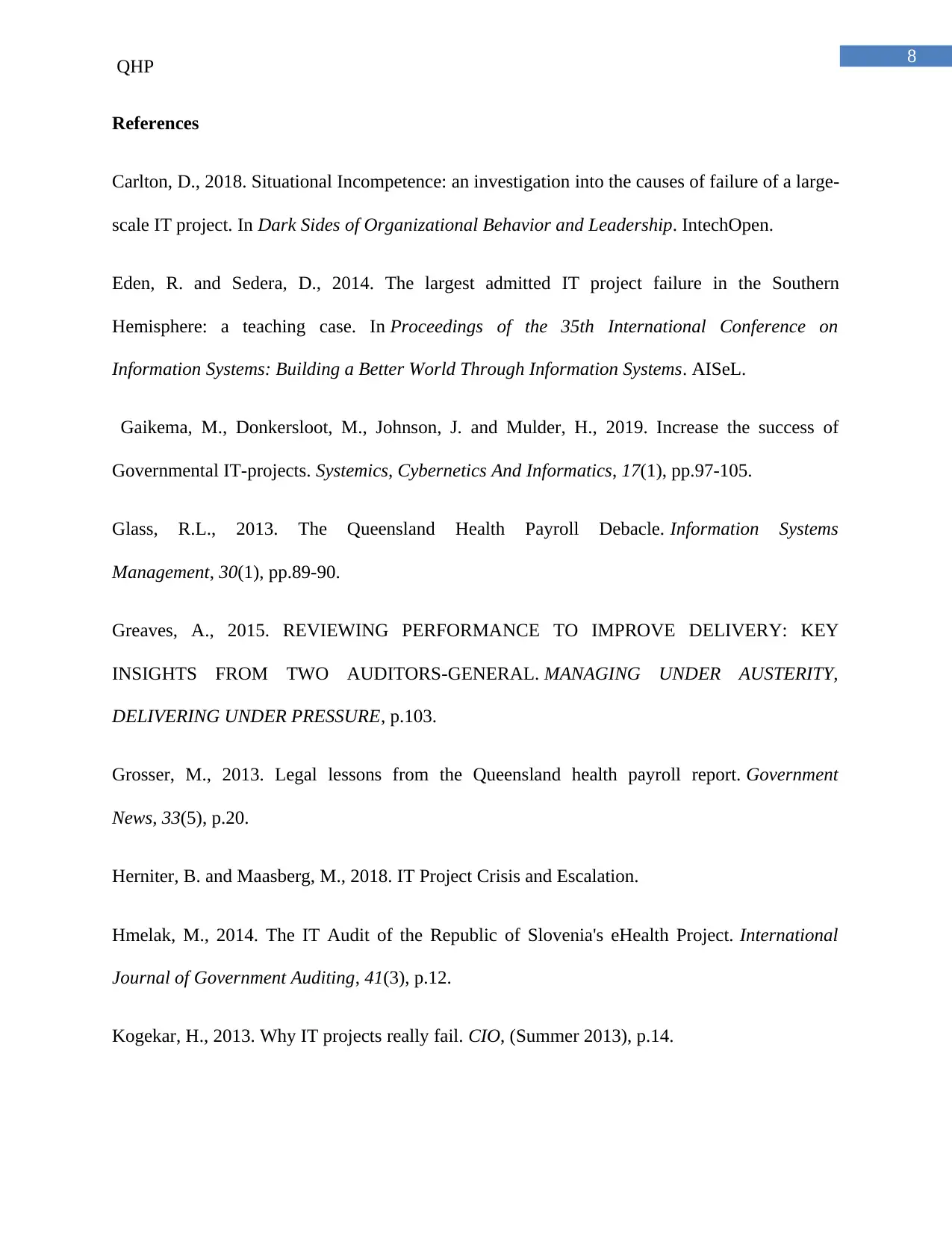
8
QHP
References
Carlton, D., 2018. Situational Incompetence: an investigation into the causes of failure of a large-
scale IT project. In Dark Sides of Organizational Behavior and Leadership. IntechOpen.
Eden, R. and Sedera, D., 2014. The largest admitted IT project failure in the Southern
Hemisphere: a teaching case. In Proceedings of the 35th International Conference on
Information Systems: Building a Better World Through Information Systems. AISeL.
Gaikema, M., Donkersloot, M., Johnson, J. and Mulder, H., 2019. Increase the success of
Governmental IT-projects. Systemics, Cybernetics And Informatics, 17(1), pp.97-105.
Glass, R.L., 2013. The Queensland Health Payroll Debacle. Information Systems
Management, 30(1), pp.89-90.
Greaves, A., 2015. REVIEWING PERFORMANCE TO IMPROVE DELIVERY: KEY
INSIGHTS FROM TWO AUDITORS-GENERAL. MANAGING UNDER AUSTERITY,
DELIVERING UNDER PRESSURE, p.103.
Grosser, M., 2013. Legal lessons from the Queensland health payroll report. Government
News, 33(5), p.20.
Herniter, B. and Maasberg, M., 2018. IT Project Crisis and Escalation.
Hmelak, M., 2014. The IT Audit of the Republic of Slovenia's eHealth Project. International
Journal of Government Auditing, 41(3), p.12.
Kogekar, H., 2013. Why IT projects really fail. CIO, (Summer 2013), p.14.
QHP
References
Carlton, D., 2018. Situational Incompetence: an investigation into the causes of failure of a large-
scale IT project. In Dark Sides of Organizational Behavior and Leadership. IntechOpen.
Eden, R. and Sedera, D., 2014. The largest admitted IT project failure in the Southern
Hemisphere: a teaching case. In Proceedings of the 35th International Conference on
Information Systems: Building a Better World Through Information Systems. AISeL.
Gaikema, M., Donkersloot, M., Johnson, J. and Mulder, H., 2019. Increase the success of
Governmental IT-projects. Systemics, Cybernetics And Informatics, 17(1), pp.97-105.
Glass, R.L., 2013. The Queensland Health Payroll Debacle. Information Systems
Management, 30(1), pp.89-90.
Greaves, A., 2015. REVIEWING PERFORMANCE TO IMPROVE DELIVERY: KEY
INSIGHTS FROM TWO AUDITORS-GENERAL. MANAGING UNDER AUSTERITY,
DELIVERING UNDER PRESSURE, p.103.
Grosser, M., 2013. Legal lessons from the Queensland health payroll report. Government
News, 33(5), p.20.
Herniter, B. and Maasberg, M., 2018. IT Project Crisis and Escalation.
Hmelak, M., 2014. The IT Audit of the Republic of Slovenia's eHealth Project. International
Journal of Government Auditing, 41(3), p.12.
Kogekar, H., 2013. Why IT projects really fail. CIO, (Summer 2013), p.14.
⊘ This is a preview!⊘
Do you want full access?
Subscribe today to unlock all pages.

Trusted by 1+ million students worldwide
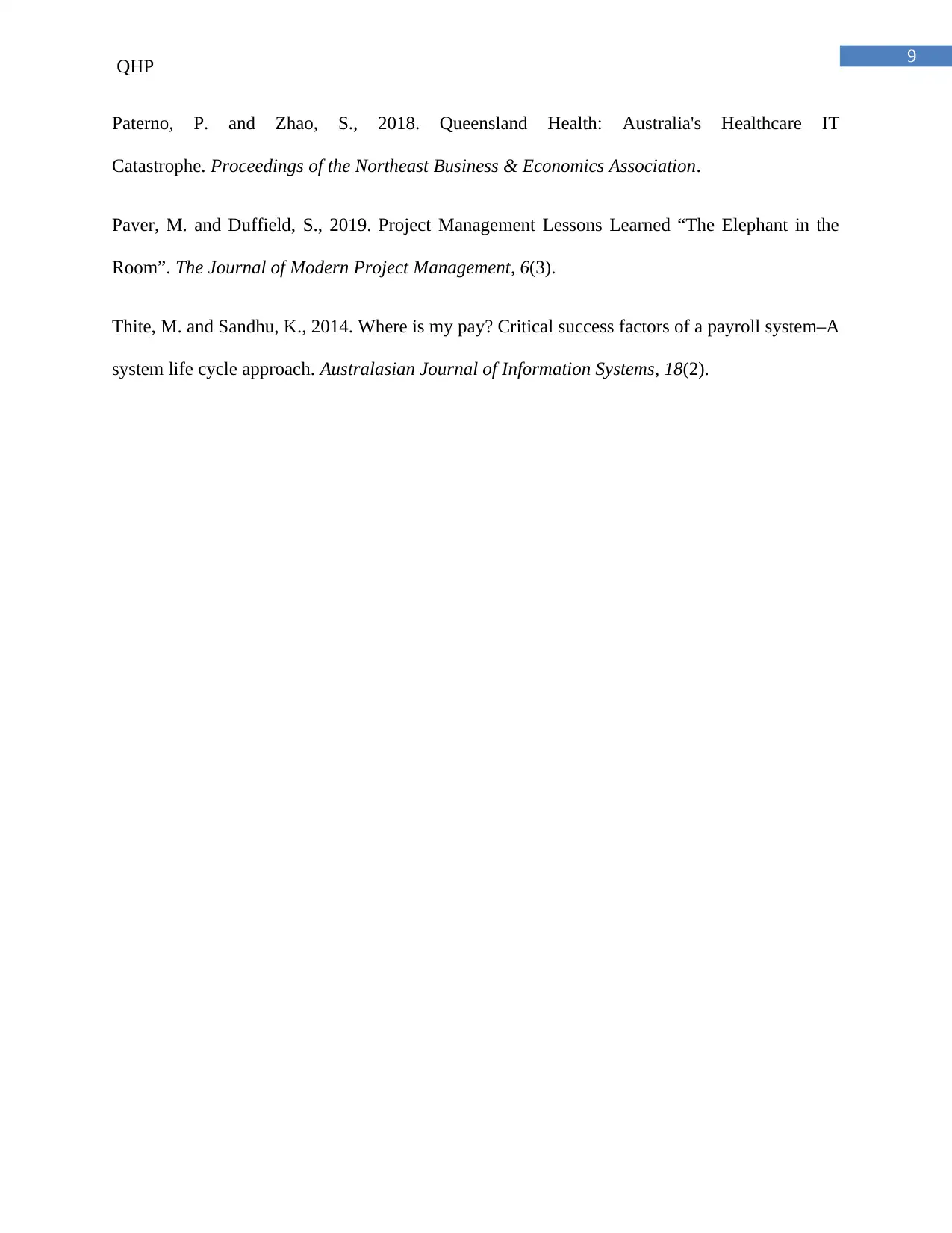
9
QHP
Paterno, P. and Zhao, S., 2018. Queensland Health: Australia's Healthcare IT
Catastrophe. Proceedings of the Northeast Business & Economics Association.
Paver, M. and Duffield, S., 2019. Project Management Lessons Learned “The Elephant in the
Room”. The Journal of Modern Project Management, 6(3).
Thite, M. and Sandhu, K., 2014. Where is my pay? Critical success factors of a payroll system–A
system life cycle approach. Australasian Journal of Information Systems, 18(2).
QHP
Paterno, P. and Zhao, S., 2018. Queensland Health: Australia's Healthcare IT
Catastrophe. Proceedings of the Northeast Business & Economics Association.
Paver, M. and Duffield, S., 2019. Project Management Lessons Learned “The Elephant in the
Room”. The Journal of Modern Project Management, 6(3).
Thite, M. and Sandhu, K., 2014. Where is my pay? Critical success factors of a payroll system–A
system life cycle approach. Australasian Journal of Information Systems, 18(2).
1 out of 10
Related Documents
Your All-in-One AI-Powered Toolkit for Academic Success.
+13062052269
info@desklib.com
Available 24*7 on WhatsApp / Email
![[object Object]](/_next/static/media/star-bottom.7253800d.svg)
Unlock your academic potential
Copyright © 2020–2025 A2Z Services. All Rights Reserved. Developed and managed by ZUCOL.





